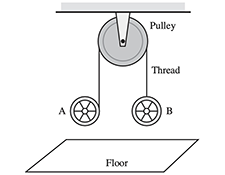
Dynamics of rigid bodies
Variant i Dynamics first Other Variants Conservation laws first
The tutorial covers the ideas of extended free-body diagrams (diagrams showing forces at the location at which they are exerted), torque, and angular and linear acceleration.
Topics Mechanics / Rotation
Materials
Materials by the UW team
- Instructor Guide


- Pretest


- Exam Questions



- Equipment List

Tutorial details
A major focus of this tutorial is on helping students learn to draw and interpret extended free- body diagrams. Many students have the incorrect idea that the linear acceleration of a body due to a force depends on where the force is exerted. Often they state that if a force is not exerted at the center of mass, then part of the force is “used up” in creating rotational motion. Exercises in the tutorial are intended to elicit this difficulty and to help students confront and resolve their incorrect ideas.
In the first section of the tutorial, students are shown a ruler suspended from a pivot through its center of mass. The ruler is initially at a slight angle to the horizontal and students are asked to predict the motion after it is released from rest. Many say the ruler will rotate and base their arguments on “equilibrium” or other ideas. After they have made predictions and have observed the motion, students are asked to draw free-body diagrams and to relate the motion of the ruler to the net torque. The observation they have made about the motion provides support for the convention of drawing the weight at the center of mass of the ruler.
Section II helps students relate the net force on an object to the object’s linear acceleration. Students predict the motion of two spools of thread when dropped. One spool is attached to a support by a vertical thread; the other is not. Many students predict that the two spools reach the ground at the same time since the force exerted by the thread is not at, or directed toward, the center of mass of the spool. If this idea does not arise among a particular group of students, it can be fruitful to raise it before giving them the equipment to check their prediction.
For instruction tips, login or register as a verified educator to see the Instructor Guide.
Prerequisites
Students should already have been introduced to the topics of angular velocity, angular acceleration and torque. The tutorial Rotational motion provides the necessary background.
Equipment
Special Instructions
Demonstration:
- 1 ruler with hole in the center. (See below)
- 1 axis and stand on which ruler can spin

List
- ring stand and dowel
- spool of thread
- white board or large sheet of paper with markers
Research
- H. G. Close, L. S. Gomez, and P. R. L. Heron, Student understanding of the application of Newton's second law to rotating rigid bodies, 81 (6) 458-470 (2013).
- H. Close and P. Heron, Student understanding of the angular momentum of classical particles, Am. J. Phys. 79 (10), 1068 (2011).
- H. Close and P. Heron, Research as a guide for improving student learning: An example from momentum conservation, Am. J. Phys. 78 (9), 961 (2010).
Coming Soon! We hope to release the discussion section on each tutorial soon.

